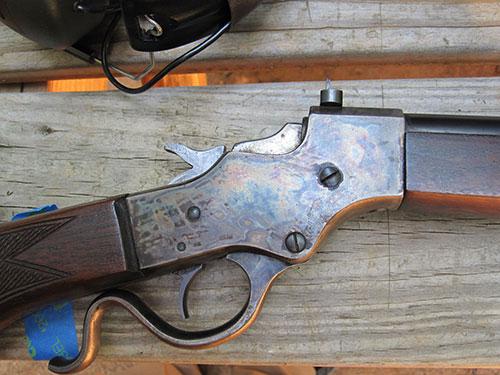
So, my in-laws were moving, and to avoid dragging them along, my father-in-law divested himself of a Mossberg 185 D 20 gauge shotgun (more on this in another post) and a Stevens 414 Armory .22 rifle. I got both of them. This post is about the rifle.
To the best I’ve been able to determine, Stevens manufactured this falling block rifle for 24 years, from 1908 to 1932, retailing for the then princely sum of $12.00. So, at the young end, this rifle is at least 82 years old. Aimed squarely at the precision shooting crowd, it soon became a favorite. The thing is massive, and built like a tank. With a 25 inch barrel that has a diameter of .75 inches, it tips the scales at 8.5 pounds. The action looks capable of handling the pressure of a .458 Winchester. When you pick this gun up, the word “solid” runs through your mind. You’ll think you’re holding a centerfire rifle.
The barrel is blued, as is the barrel band and buttplate. The receiver, lever, hammer, and block are color case hardened. The stock is walnut.
A falling block action ensures a very tight lock up of bolt face to breech, which is one of the reasons this rifle was prized for its accuracy. The U.S. Olympic Shooting team took the gold medal with 414 Armory models in the 1910 Olympics. These rifles normally had a scope mounted on them. The example I have is drilled and tapped on the barrel for scope mounts. The mounting holes would put the scope bases 7 inches apart from center to center. Not unusual in a time when scopes were almost 2 feet long.

Stored in a case for more years than I’d care to think about, it’s still in remarkably good shape. Cosmetically, there is a crack in the buttstock, the bluing is worn in spots on the barrel. Mechanically, the hammer would not stay cocked. Disassembly and inspection showed that the sear notch in the hammer had somehow become rounded. A few judicious touches with a file restored it back to the proper angles. With an action that relied on an economy of moving parts, effecting repairs is relatively simple. Care must be taken though, as taking a little too much off something can make the rifle unusable. Even Numrich arms has its limits when it comes to replacement parts. Trigger pull is 4.25 pounds, with absolutely no creep and a very crisp let off.
Now, I’m not a gun collector. If I have it, it gets shot. A trip to the range to verify that I did in fact get the sear angle right on the hammer proved this gun to be a solid shooter. Sights consist of a very small aperture rear sight and a blade and bead front. It was impossible to adjust the point of impact to match point of aim as the rear sight windage adjustment is currently frozen in place. The rifle did do a respectable job with Remington Viper hollow points.

I’ll be doing a restoration on this rifle as time permits. Generally cleaning it up, repairing the buttstock, and mounting a period scope if I can find one.




